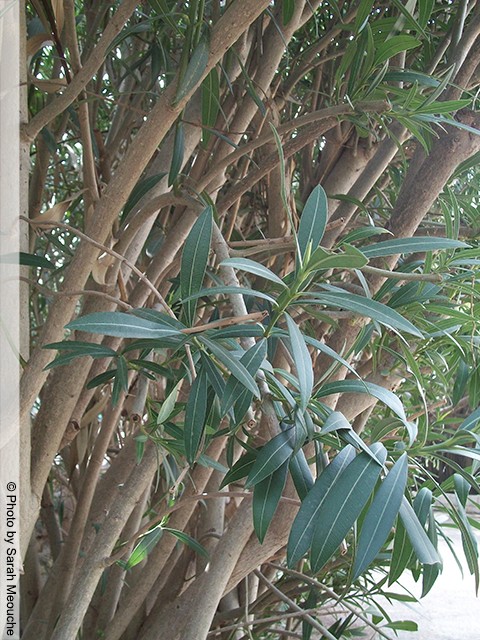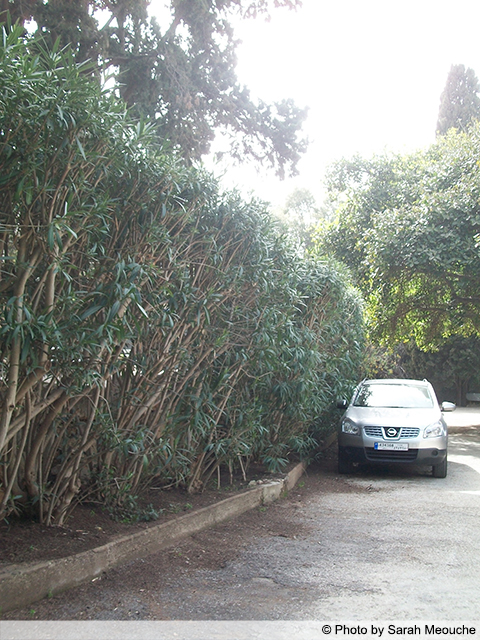Nerium oleander (Oleander)
Oleander is a wonderful easy-care, rounded or upright shrub or small tree from the Mediterranean region , with long, dark green leaves and an a single or double, sometimes fragrant flowers in shades of white, pink, red, or yellow. All parts of the plant are poisonous so care must be taken when locating Oleander near areas frequented by small children; burning of the trimmings will produce toxic fumes. Even chewing once or twice on a leaf or twig can send a person to the hospital. Growing well with only one yearly fertilization and springtime pruning, Oleander is one of the easiest shrubs to care for. Oleander survives drought well and is well-suited to growing on soil too poor for most other shrubs, even tolerating salt spray. It thrives in full sun, appearing too lanky and flowering little if planted in partial shade. The main pest can appear on the plant is the oleander caterpillar which can defoliate the plant within weeks. It is commonly planted in highway medians as a no-maintenance plant. Often trained into an attractive small tree, multi-branched Oleander also does well as a quick-growing screen or large specimen planting. Many cultivars are available single or double flowers, normal or variegated leaves, dwarf or normal sizes.
- Landscape Information
- Botanical Description
- Horticulture Management
-
By AlphaCentauri (Own work) [GFDL (http://www.gnu.org/copyleft/fdl.html), CC-BY-SA-3.0 (http://creativecommons.org/licenses/by-sa/3.0/) or CC BY 2.5 (http://creativecommons.org/licenses/by/2.5)], via Wikimedia Commons
-
By Alvesgaspar (Own work) [GFDL (http://www.gnu.org/copyleft/fdl.html), CC-BY-SA-3.0 (http://creativecommons.org/licenses/by-sa/3.0/) or CC BY 2.5 (http://creativecommons.org/licenses/by/2.5)], via Wikimedia Commons
-
By Júlio Reis (Original file) [CC BY-SA 3.0 (http://creativecommons.org/licenses/by-sa/3.0)], via Wikimedia Commons
-
-
-
Search plant on Google
Download as PDF
-
French Name: Laurier rose, Laurose, Nérion
Arabic Name: دفلى
Pronunciation: NEER-ee-um oh-lee-AN-der
-
Plant type: Shrub
-
Origin: Mediterranean region
-
Heat Zones: 1 to 16
Hardiness Zones: 8 to 13
-
Uses: Screen, Hedge, Container, Wildlife, Street, Pollution Tolerant / Urban, Reclamation
-
Size/Shape
Growth Rate: Fast
Tree Shape: Upright
Canopy Symmetry: Symmetrical
Canopy Density: Medium
Canopy Texture: Medium
Height at Maturity: 3 to 5 m
Spread at Maturity: 3 to 5 meters
Time to Ultimate Height: 10 to 20 Years
-
By AlphaCentauri (Own work) [GFDL (http://www.gnu.org/copyleft/fdl.html), CC-BY-SA-3.0 (http://creativecommons.org/licenses/by-sa/3.0/) or CC BY 2.5 (http://creativecommons.org/licenses/by/2.5)], via Wikimedia Commons
-
By Alvesgaspar (Own work) [GFDL (http://www.gnu.org/copyleft/fdl.html), CC-BY-SA-3.0 (http://creativecommons.org/licenses/by-sa/3.0/) or CC BY 2.5 (http://creativecommons.org/licenses/by/2.5)], via Wikimedia Commons
-
By Júlio Reis (Original file) [CC BY-SA 3.0 (http://creativecommons.org/licenses/by-sa/3.0)], via Wikimedia Commons
-
-
-
Search plant on Google
Download as PDF
-
Foliage
Leaf Arrangement : Opposite
Leaf Venation: Pinnate
Leaf Persistance: Evergreen
Leaf Type: Simple
Leaf Blade: 5 - 10 cm
Leaf Shape: Linear
Leaf Margins: Entire
Leaf Texture: Rough
Leaf Scent: Unpleasant
Color(growing season): Green
Color(changing season): Green
-
Flower
Flower Size Range: 10 - 20
Flower Type: Cyme
Flower Sexuality: Monoecious (Bisexual)
Flower Scent: Pleasant (Sweet)
Flower Color: Red, Purple, White, Pink
Seasons: Summer, Fall
-
Trunk
Trunk Susceptibility to Breakage: Suspected to breakage
Number of Trunks: Can be trained to one trunk
Trunk esthetic Values: Not Showy
-
Fruit
Fruit Type: Legume
Fruit Showiness: Yes
Fruit Size Range: 7 - 10
Fruit Color: Black
Seasons: Summer, Fall
-
By AlphaCentauri (Own work) [GFDL (http://www.gnu.org/copyleft/fdl.html), CC-BY-SA-3.0 (http://creativecommons.org/licenses/by-sa/3.0/) or CC BY 2.5 (http://creativecommons.org/licenses/by/2.5)], via Wikimedia Commons
-
By Alvesgaspar (Own work) [GFDL (http://www.gnu.org/copyleft/fdl.html), CC-BY-SA-3.0 (http://creativecommons.org/licenses/by-sa/3.0/) or CC BY 2.5 (http://creativecommons.org/licenses/by/2.5)], via Wikimedia Commons
-
By Júlio Reis (Original file) [CC BY-SA 3.0 (http://creativecommons.org/licenses/by-sa/3.0)], via Wikimedia Commons
-
-
-
Search plant on Google
Download as PDF
-
Tolerance
Frost Tolerant: Yes
Heat Tolerance: Yes
Salt Tolerance: Moderate
-
Requirements
Soil Requirements: Clay, Loam, Sand
Soil Ph Requirements: Acidic, Neutral
Water Requirements: Moderate, Low
Light Requirements: Full
-
Management
Toxicity: Yes
Susceptibility to Pests and Diseases: Yes
Pruning Requirements: Needed, to develop a strong structure
Fruit/ Leaves/ Flowers litter: No
Life Span: 25-50 years
Edible Parts: None
Plant Propagation: Seed, Cutting



